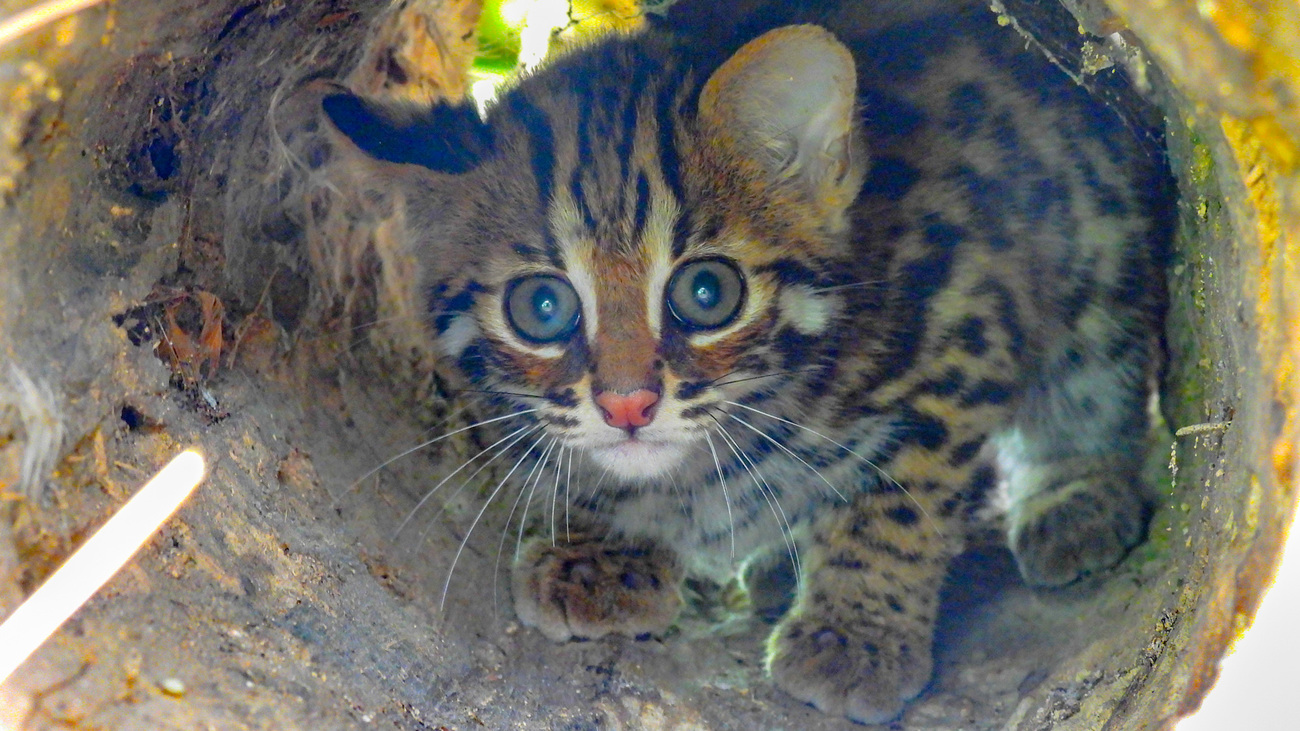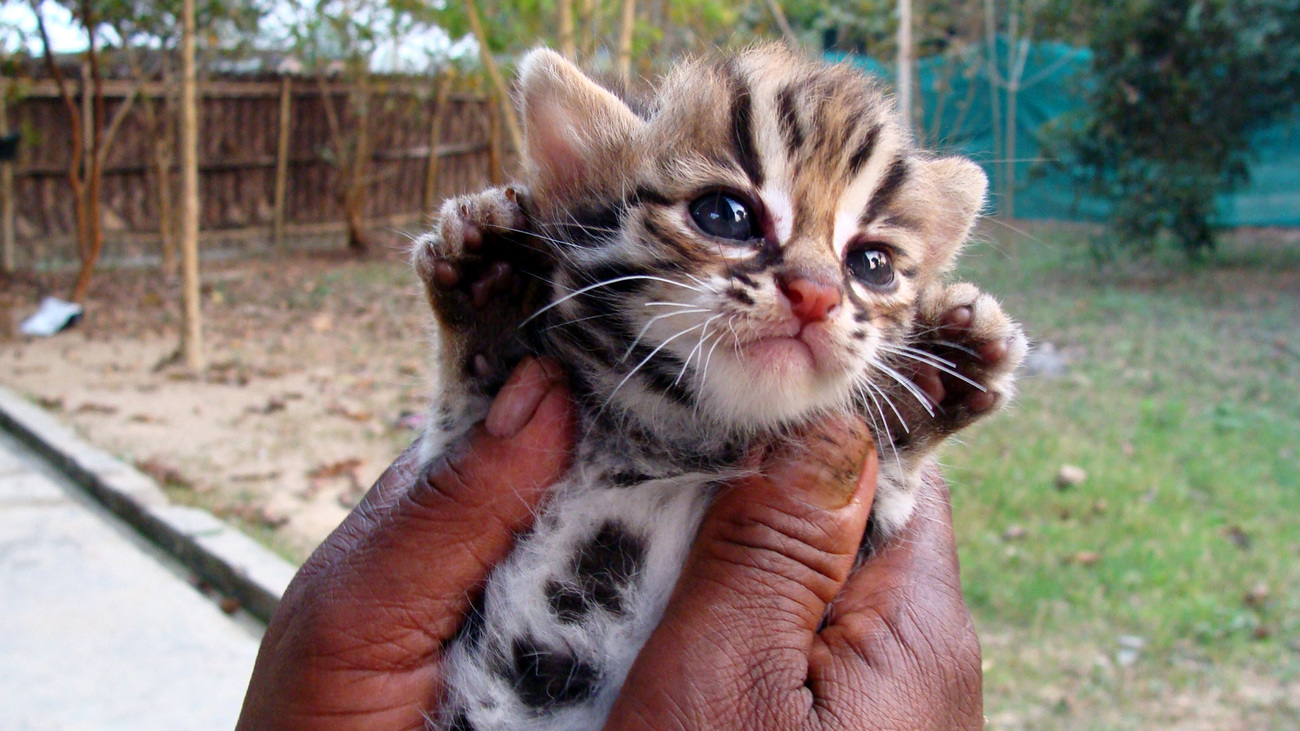Centre for Wildlife Rehabilitation and Conservation - India
Near Kaziranga National Park, animals are being threatened by a single highwayThe challenges of hand-raising leopard cat orphans
The challenges of hand-raising leopard cat orphans

About the size of a domestic housecat and found in South, Southeast, and East Asia, leopard cats are a protected species in many areas where their population has declined. Outside of India, the fur and pet trade are their biggest threats leopard cats face. In India, while hunting poses a threat, the more prevalent danger is compassionate, but misguided human intervention—which is how fifteen leopard cat kittens ended up in the care of IFAW and our partner Wildlife Trust of India (WTI), with whom we founded the Centre for Wildlife Rehabilitation and Conservation (CWRC).
When leopard cat mothers go out to hunt, they leave their young hidden in locations safe from natural predators. Humans are not a natural predator to the leopard cat, but when people see kittens all alone, they are tempted to remove them from the site, assuming the kittens have been abandoned.
The fifteen kittens were found by villagers and reported to the IFAW-WTI Mobile Veterinary Service (MVS) unit, which operates a satellite station for the CWRC and responds to wildlife in crisis. The process of hand-raising these fifteen orphaned wild cats was detailed in an article written by members of WTI that was published in the Journal of Wildlife Rehabilitation.
Attempting to reunite kittens with their mothers
Between 2015 and 2021, villagers found and brought to the MVS station three litters of two or three kittens each along with eight individuals on their own. One kitten’s mother was confirmed dead, but the rest were returned to the locations where they were found, in case they were not truly orphaned. Sometimes the sound of the kitten’s cry is enough to lead a mother back if she is nearby.
After reunion attempts were deemed unsuccessful, the team brought the kittens back to the MVS field station at the Bodoland Wildlife Transit Home to be hand-raised.
The choice to hand-raise orphaned wildlife is never made lightly. Nothing can truly compare to the care a mother provides her young in the wild. Every step from acquiring adequate milk replacements to providing appropriate social and developmental opportunities can be challenging.
Little research existed to guide us on the specific needs of leopard cats. Kittens can be especially difficult to rear due to how impressionable they are. Careful consideration must be taken to provide the kittens with the care they need to grow and remain healthy, while also severely limiting human interaction to keep them wild.
The first few weeks are critical
Orphans taken into any of our rehabilitation sites receive full veterinary examinations, care, and species-specific vaccinations. Protocols are followed to attempt to replicate a mother’s care, but that doesn’t guarantee their survival. The stress, injuries, and diseases an orphan may have suffered prior to rescue can sometimes be too much to bear.
Due to poor health upon admittance, one leopard cat succumbed to a secondary infection within nine days of arrival. One died from a bacterial infection. Two others tested positive for canine distemper, which may be the first cases of such mortality witnessed in leopard cats in India.
A substitute for leopard cat milk had to be acquired to bottle feed the kittens, but resources were limited. Kitten milk replacement is the closest to leopard cat milk in macronutrient proportions, but it was unavailable locally, so cow’s milk had to be used instead.

Keeping wildlife wild when they need human intervention
Providing care while keeping wildlife wild is a delicate balancing act. We know from other rehabilitation experiences that if big cats acclimate to human interaction, they may never be safely returned to the wild.
Pack and herd animals have an advantage in rehabilitation because we can step aside and hand off some responsibilities to members of their own species. Elephant elders can teach calves how to forage, pack animals can teach younger members to hunt, and herd animals can educate orphans in ways we humans never could.
But leopard cats are solitary by nature. Adults only interact when mating. A mother rears her litter of two or three young for only a few months before they become fully independent.
With their mother absent, the team had to present opportunities for the orphans to learn on their own. Once the leopard cats were old enough to leave the nursery, they moved to large outdoor enclosures. Human contact was eliminated, and feeding was done remotely. Chickens, rodents, and small animals were released into their enclosures for the cats to learn how to stalk and hunt their prey.
Individual cats were paired up to alleviate boredom and promote social learning, as they might in a litter. Although reluctant to interact at first, they began denning together after a week. By three months old, all the cats were proficient in attaining their meals, proving that they were ready for release.
Returning to the wild
The cats remained in small enclosures for an average of 20 days to acclimate to the release sites and were monitored by remote cameras. Once the doors opened, the cats took their leave, but were not captured on nearby cameras after departing.
No research was found on the size of enclosure or days needed for leopard cats to acclimate to the release site, but in comparing these outcomes to other big cat releases, we believe that if the cats had larger enclosures, they would have been able to explore more of the land and become habituated to the release site.
The impact of every story
Wildlife rescue with limited resources in remote locations is challenging, but when we share our experiences, we’re able to connect with others and discuss solutions to those challenges. WTI’s article reached 1500 professional wildlife rescue individuals and organisations across the globe, making the experiences of those fifteen leopard cats a part of the collective wisdom.
Every animal is an individual and every rescue is unique, but IFAW’s rescue work transcends the individual that returns to the wild. The stories of the animals we help rescue and rehabilitate write a living encyclopedia of experiences that grows every day with each new animal we care for, guiding us on how to do better. When we share those experiences with others, we make an impact on wildlife well beyond our immediate reach.
Related content
Every problem has a solution, every solution needs support.
The problems we face are urgent, complicated, and resistant to change. Real solutions demand creativity, hard work and involvement from people like you.